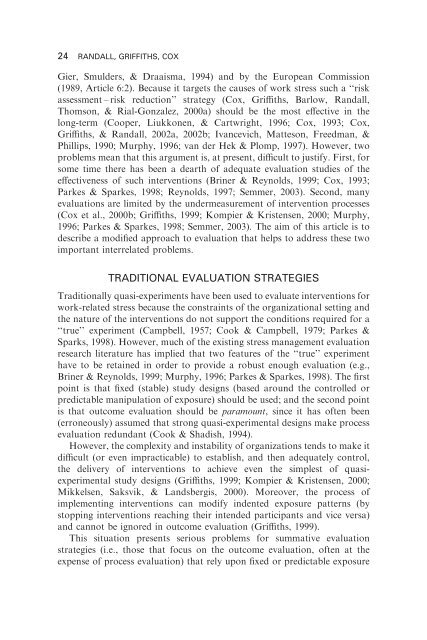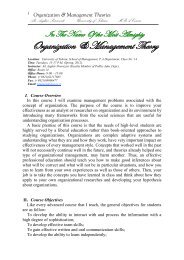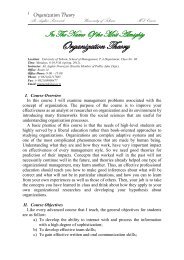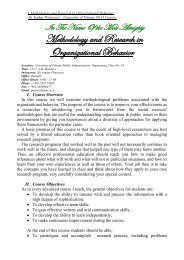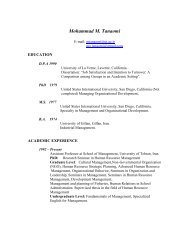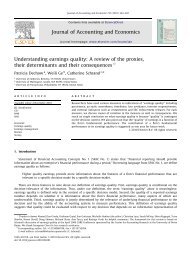Evaluating organizational stress-management interventions using ...
Evaluating organizational stress-management interventions using ...
Evaluating organizational stress-management interventions using ...
You also want an ePaper? Increase the reach of your titles
YUMPU automatically turns print PDFs into web optimized ePapers that Google loves.
24 RANDALL, GRIFFITHS, COX<br />
Gier, Smulders, & Draaisma, 1994) and by the European Commission<br />
(1989, Article 6:2). Because it targets the causes of work <strong>stress</strong> such a ‘‘risk<br />
assessment – risk reduction’’ strategy (Cox, Griffiths, Barlow, Randall,<br />
Thomson, & Rial-Gonzalez, 2000a) should be the most effective in the<br />
long-term (Cooper, Liukkonen, & Cartwright, 1996; Cox, 1993; Cox,<br />
Griffiths, & Randall, 2002a, 2002b; Ivancevich, Matteson, Freedman, &<br />
Phillips, 1990; Murphy, 1996; van der Hek & Plomp, 1997). However, two<br />
problems mean that this argument is, at present, difficult to justify. First, for<br />
some time there has been a dearth of adequate evaluation studies of the<br />
effectiveness of such <strong>interventions</strong> (Briner & Reynolds, 1999; Cox, 1993;<br />
Parkes & Sparkes, 1998; Reynolds, 1997; Semmer, 2003). Second, many<br />
evaluations are limited by the undermeasurement of intervention processes<br />
(Cox et al., 2000b; Griffiths, 1999; Kompier & Kristensen, 2000; Murphy,<br />
1996; Parkes & Sparkes, 1998; Semmer, 2003). The aim of this article is to<br />
describe a modified approach to evaluation that helps to address these two<br />
important interrelated problems.<br />
TRADITIONAL EVALUATION STRATEGIES<br />
Traditionally quasi-experiments have been used to evaluate <strong>interventions</strong> for<br />
work-related <strong>stress</strong> because the constraints of the <strong>organizational</strong> setting and<br />
the nature of the <strong>interventions</strong> do not support the conditions required for a<br />
‘‘true’’ experiment (Campbell, 1957; Cook & Campbell, 1979; Parkes &<br />
Sparks, 1998). However, much of the existing <strong>stress</strong> <strong>management</strong> evaluation<br />
research literature has implied that two features of the ‘‘true’’ experiment<br />
have to be retained in order to provide a robust enough evaluation (e.g.,<br />
Briner & Reynolds, 1999; Murphy, 1996; Parkes & Sparkes, 1998). The first<br />
point is that fixed (stable) study designs (based around the controlled or<br />
predictable manipulation of exposure) should be used; and the second point<br />
is that outcome evaluation should be paramount, since it has often been<br />
(erroneously) assumed that strong quasi-experimental designs make process<br />
evaluation redundant (Cook & Shadish, 1994).<br />
However, the complexity and instability of organizations tends to make it<br />
difficult (or even impracticable) to establish, and then adequately control,<br />
the delivery of <strong>interventions</strong> to achieve even the simplest of quasiexperimental<br />
study designs (Griffiths, 1999; Kompier & Kristensen, 2000;<br />
Mikkelsen, Saksvik, & Landsbergis, 2000). Moreover, the process of<br />
implementing <strong>interventions</strong> can modify indented exposure patterns (by<br />
stopping <strong>interventions</strong> reaching their intended participants and vice versa)<br />
and cannot be ignored in outcome evaluation (Griffiths, 1999).<br />
This situation presents serious problems for summative evaluation<br />
strategies (i.e., those that focus on the outcome evaluation, often at the<br />
expense of process evaluation) that rely upon fixed or predictable exposure


